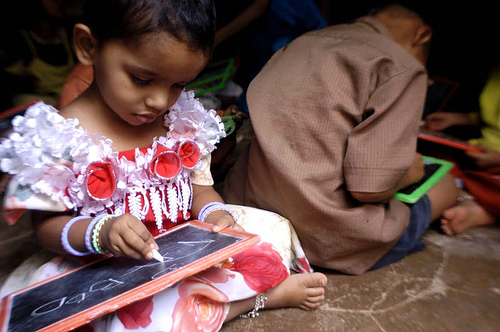Of Prime Importance

Manisha Chaudhry writes about a seminar she attended recently.
Shaktibrata Sen, our erudite colleague who heads the content creation group in Pratham, set the context. Literacy is a word of manifold layers. While pointing out that literacy could range from the ability to sign your name to developing an ability to read, he shared the learning graph of Pratham in looking at different ways to make a child literate and then a reader. There is little research on how literacy primers have been made in India. The ability to read is not only decoding at an efficient speed as the degree to which fluency aids comprehension varies. He also pointed out that different children use different processes to learn to read and the basal texts created for them have to incorporate layers of linguistic considerations that recognize these differences. While outlining the major research done in this area which relies on the ways the human brain learns to read, he clearly explicated the need for variety but which needs to be created scientifically. Since Bangla is one language where more than 500 primers have been created and academics have studied them, that knowledge is informing how primers and texts are being created today.
In his very interesting talk, Prof Majumdar of Jadavpur Univ gave a historical perspective on the literacy primers published since 1816 onwards. He then shared some of the most significant details of the primers that had an influence on education for a long time.He also linked the ideological positions and political developments of the time as well as the history of printing with the publication of primers.
The earliest primer Shishu Shiksha by Madan Mohun displayed natural gender sensitivity as it addressed girls of Bethune School and the extensive use of rhyme and word play drawing upon the immediate environment of the child displayed a remarkable alignment with modern ideas around materials for primary education. The primers by Ishwar Chand Vidyasagar, Barna Parichay strangely enough, don’t mention girls at all, even though he set up 1500 schools for girls’ education. Moreover , he relies extensively on prose to move between script, language and letters. The attempt to make letters easier to learn was also evident in how the primers introduced similar looking letters in succession, even departing from the order in the varna mala. While illustrations were used, a few primers by Abanindranath Tagore attempted to illustrate graphemes by finding parallels from the physical world of the child.
Prof Majumdar concluded with extensive sharing on the genius of Sahaj Path written by Tagore. Tagore took 41 years to write two primers and they are truly great works of literature.
It was an interactive session where we all learnt a lot and were also inspired to look at primers in all their importance. The lesson to draw from the study of primers was that nowhere do they talk down to children. They also create interesting word pictures and stay clear of direct moralising even if the tone may sometimes be admonitory. Sahaj Path , particularly is very poetic and uses rich language within the framework of teaching children matras gradually. The texts are apparently very simple but they demonstrate literary craft of the highest order as it is completely invisible. Like all timeless literature, they can be enjoyed by children and adults alike.
Image Credit : Pratham Books









